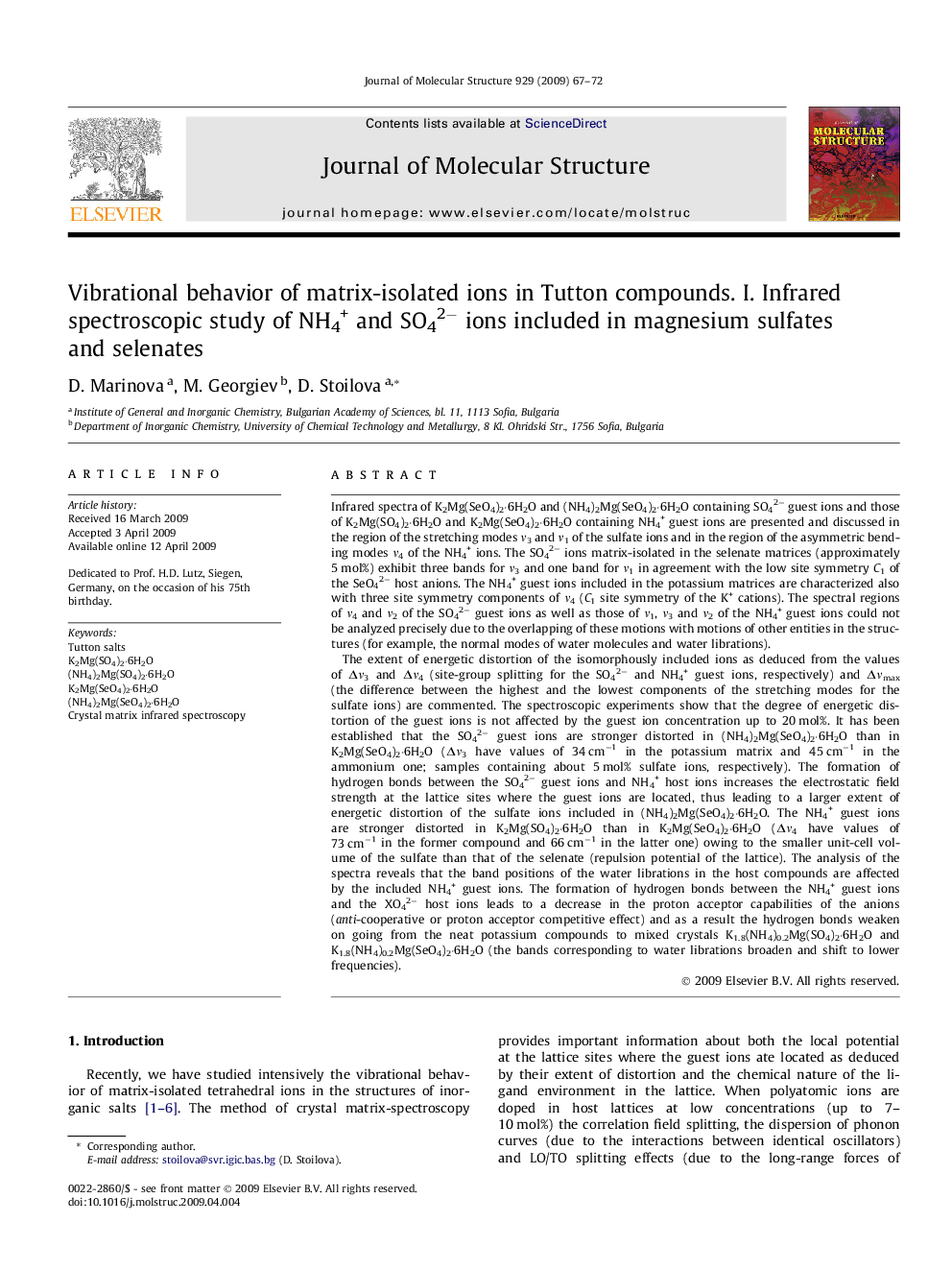| کد مقاله | کد نشریه | سال انتشار | مقاله انگلیسی | نسخه تمام متن |
|---|---|---|---|---|
| 1406553 | 1501861 | 2009 | 6 صفحه PDF | دانلود رایگان |

Infrared spectra of K2Mg(SeO4)2·6H2O and (NH4)2Mg(SeO4)2·6H2O containing SO42− guest ions and those of K2Mg(SO4)2·6H2O and K2Mg(SeO4)2·6H2O containing NH4+ guest ions are presented and discussed in the region of the stretching modes ν3 and ν1 of the sulfate ions and in the region of the asymmetric bending modes ν4 of the NH4+ ions. The SO42− ions matrix-isolated in the selenate matrices (approximately 5 mol%) exhibit three bands for ν3 and one band for ν1 in agreement with the low site symmetry C1 of the SeO42− host anions. The NH4+ guest ions included in the potassium matrices are characterized also with three site symmetry components of ν4 (C1 site symmetry of the K+ cations). The spectral regions of ν4 and ν2 of the SO42− guest ions as well as those of ν1, ν3 and ν2 of the NH4+ guest ions could not be analyzed precisely due to the overlapping of these motions with motions of other entities in the structures (for example, the normal modes of water molecules and water librations).The extent of energetic distortion of the isomorphously included ions as deduced from the values of Δν3 and Δν4 (site-group splitting for the SO42− and NH4+ guest ions, respectively) and Δνmax (the difference between the highest and the lowest components of the stretching modes for the sulfate ions) are commented. The spectroscopic experiments show that the degree of energetic distortion of the guest ions is not affected by the guest ion concentration up to 20 mol%. It has been established that the SO42− guest ions are stronger distorted in (NH4)2Mg(SeO4)2·6H2O than in K2Mg(SeO4)2·6H2O (Δν3 have values of 34 cm−1 in the potassium matrix and 45 cm−1 in the ammonium one; samples containing about 5 mol% sulfate ions, respectively). The formation of hydrogen bonds between the SO42− guest ions and NH4+ host ions increases the electrostatic field strength at the lattice sites where the guest ions are located, thus leading to a larger extent of energetic distortion of the sulfate ions included in (NH4)2Mg(SeO4)2·6H2O. The NH4+ guest ions are stronger distorted in K2Mg(SO4)2·6H2O than in K2Mg(SeO4)2·6H2O (Δν4 have values of 73 cm−1 in the former compound and 66 cm−1 in the latter one) owing to the smaller unit-cell volume of the sulfate than that of the selenate (repulsion potential of the lattice). The analysis of the spectra reveals that the band positions of the water librations in the host compounds are affected by the included NH4+ guest ions. The formation of hydrogen bonds between the NH4+ guest ions and the XO42− host ions leads to a decrease in the proton acceptor capabilities of the anions (anti-cooperative or proton acceptor competitive effect) and as a result the hydrogen bonds weaken on going from the neat potassium compounds to mixed crystals K1.8(NH4)0.2Mg(SO4)2·6H2O and K1.8(NH4)0.2Mg(SeO4)2·6H2O (the bands corresponding to water librations broaden and shift to lower frequencies).
Journal: Journal of Molecular Structure - Volume 929, Issues 1–3, 16 July 2009, Pages 67–72